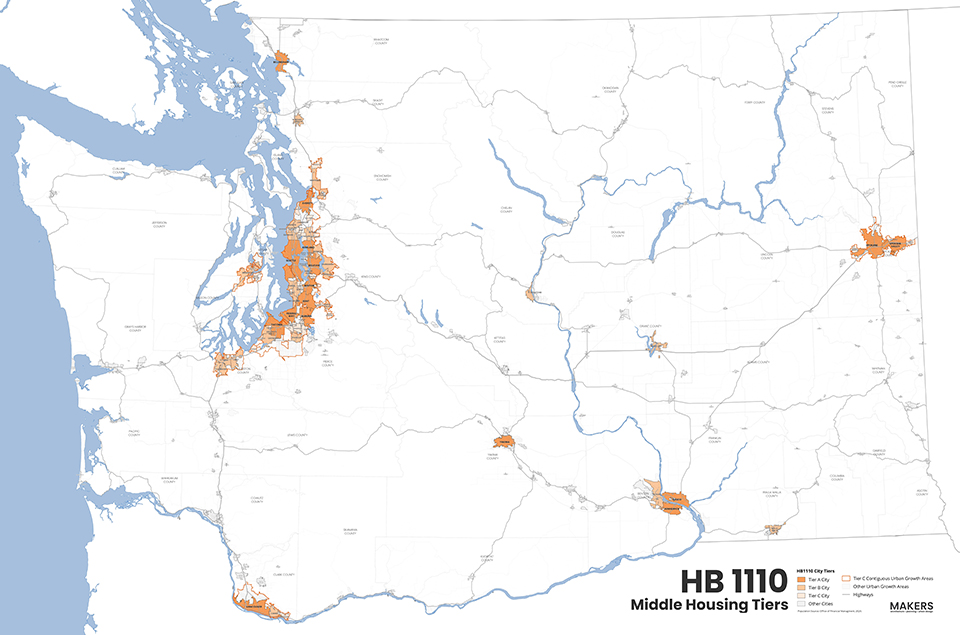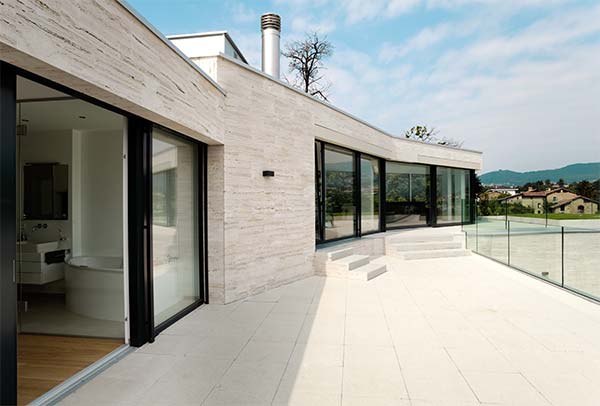
House Bill 1110 and Expanding Residential Opportunities
We’ve been hearing about this “middle housing” thing and the changes it will bring to Washington State. Earlier this month, State legislators adopted House Bill 1110 which formally requires jurisdictions to allow more housing typologies and housing density throughout the most densely populated areas. The map above by Makers shows where the various areas of change are concentrated.
THANKS, THAT’S NICE. WHAT’S MIDDLE HOUSING?
Middle housing (or “missing” middle housing) typically refers to a range of housing types that can provide more than one housing unit per lot in a way that is compatible in scale, form, and character with single-family homes. Middle housing types include duplex, tri-plex, four-plex, five-plex, six-plex, townhouses, stacked flats, courtyard apartments, and cottage housing. These other types of housing help provide a number of benefits, including but not limited to:
- Improve affordability of housing by providing a lot more of it. The additional density allowed on parcels means more homes for more people.
- Middle housing is inherently less expensive, both to build and to buy or rent. The units will be smaller than a traditional single family home, and they only use a portion of the lot so therefore the per-unit land costs are lower as well.
- Housing types such as rowhomes and townhomes work well as home-ownership alternatives to traditional single-family homes, offering lower cost options for home buyers.
- Middle housing building types are smaller in scale than the medium- and large-sized residential buildings commonly associated with urban environments. They offer a great way to provide more density in smaller increments, creating a more diverse neighborhood over time and minimizing the impacts of the development itself.
- Affordable housing comes in all sizes and shapes with middle housing, offering a wider range of home sizes and costs. Homeowners and renters will have more choices in where they live while staying within their neighborhood or community at large instead of making a choice between larger, more expensive options – or nothing at all.
- Housing units that cost less to build means more benefits to local community members. Local builders can contribute to the housing supply without competing with out of town, large scale developers. Housing units remain closer to job opportunities for essential workers and local community members like teachers, firefighters, and childcare workers.
- Smaller units means less carbon footprint and a more sustainable design option. HB1110 requires only those cities with populations meeting criteria thresholds must comply with the density requirements, which includes locating the highest densities near mass transit and other options which reduce one’s dependency on automobiles.
Image examples of each housing type shown below:

WHY DO I CARE? HOW DOES THIS IMPACT ME?
Good thing you asked, as it will impact you no matter where you live if you’re in any one of the communities that’s currently going through the code changes mandated by HB1110. Here are two good reasons to pay attention:
- If you want to develop your home or otherwise expand your residentially zoned property to include more units, these code changes may be the best way for you to do that.
- If you own your own home, the neighbors may be able to build something like this next door to you. See #1 above.
These changes may be big compared to what has happened in recent years. Prior code changes in most jurisdictions make small changes in slow, predictable code update cycles every few years, while the middle housing code changes will be broad in scope and implemented in full upon becoming adopted code. Given that HB1110 mandates that the local jurisdictions have to comply with the state codes, eventually these changes will make it to a city near you whether you like it or not.
OK, SO WHEN DOES ALL THIS HAPPEN TO ME? OR DID IT ALREADY HAPPEN???
No worries, the codes aren’t yet but they are coming. What makes this process a bit elusive on a larger scale is that HB1110, a piece of state legislation, requires individual jurisdictions to comply within certain timelines. The first timeline applies to when the jurisdiction next updates their comprehensive plan (or “comp plan”) – that’s coming up fast almost everywhere. Second step is that the jurisdictions have to update their zoning codes within a number of months to be in compliance with the updated comp plan after that. What’s the difference between a comp plan and the zoning code? In simplistic terms, think of a comp plan as the “game” you want to play, and the zoning code as the “rules of the game”. We can make up all the changes we want and agree to for the game of football, but if we’re playing basketball then it doesn’t matter, and vice versa. HB1110 is literally and figuratively a game-changing event to which all the jurisdictions have to act. Lucky for them, they do it on their own schedule. Unlucky for us, each timeline is unique since it’s on their individual schedule. Our plan for now is to follow these changes and keep you posted with what we find out. Stay tuned for updates as over the coming months!








No Comments
Sorry, the comment form is closed at this time.